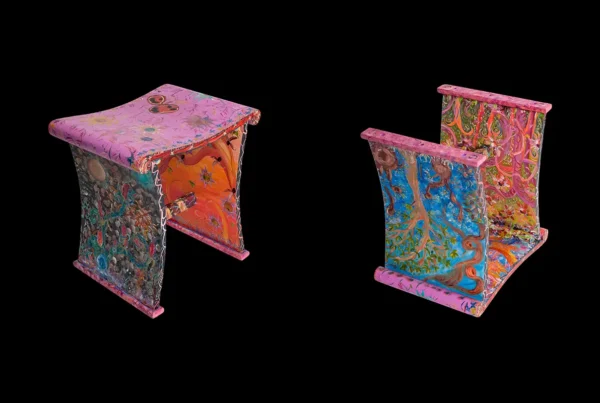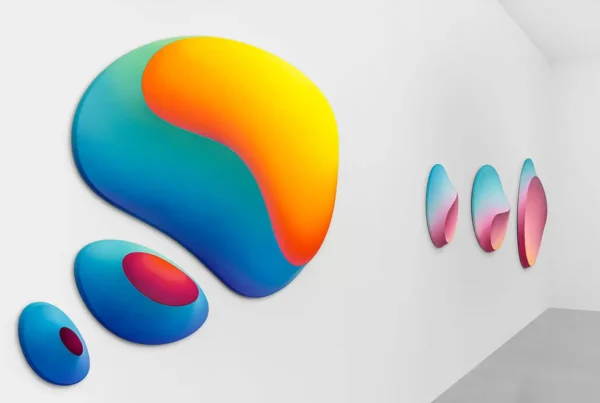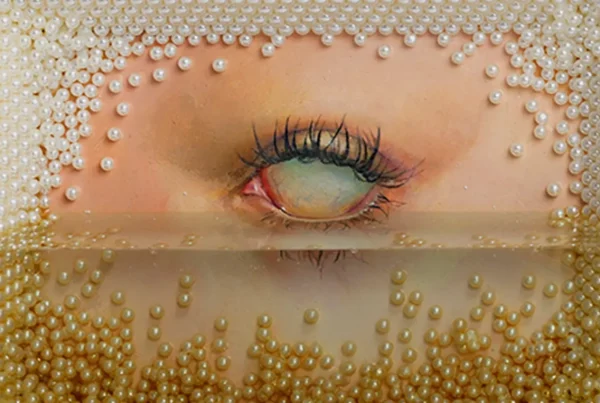“The characters I draw are myself: vessels of my emotions that have lost their place, androgynous children who have gender dysphoria and misogyny built into them, and lonely feelings that want someone to understand and love them.”
Blurring the Lines: Cuteness Meets Horror in the Art of Hikari Shimoda
Hikari Shimoda, a contemporary Japanese artist from Nagano, has captivated the international art scene with her visually arresting portraits that explore the dichotomies of innocence and fear. Born in 1984, Shimoda’s journey into art began with studies in illustration at Kyoto Saga University of Art and the Aoyama Juku School. It wasn’t long before she launched her career in earnest, showcasing her debut solo exhibition at Motto Gallery in Tokyo in 2008. Since then, her work has continued to reach an increasingly broad audience, with annual exhibitions that span across Japan, North America, and Europe, firmly establishing her as a prominent figure in contemporary art.
Shimoda’s distinctive style draws from her childhood influences, particularly manga and anime, which permeate her creative narrative. Her art often features children with large, starry eyes, clothed in superhero or “magical girl” attire—icons deeply rooted in Japanese pop culture. These children are more than mere figures; they embody complex themes of identity, collective consciousness, and social critique. By juxtaposing their colorful costumes with the somber, vacant expressions they wear, Shimoda investigates the expectations and burdens placed on younger generations, urging viewers to ponder what heroism and innocence truly signify in an ever-complicated world.
A pivotal aspect of Shimoda’s portfolio is the series “Children of This Planet” and “Whereabouts of God,” where her child-like subjects are adorned with symbolic elements such as horns or necklaces referencing Chernobyl. These motifs, layered with a childlike wonder, are a powerful reflection on global issues, including the profound impacts of the 2011 Fukushima disaster. Through her use of these “blank canvas” children, she intricately weaves together the threads of imagination, past trauma, and potential futures, creating a haunting yet hopeful commentary on the collective human experience.

Hikari Shimoda: Emotions Encapsulated in the Eyes of a Child
Shimoda’s artistic expressions are largely channeled through the eyes of her characters, which often occupy a striking focal point in her paintings. These eyes, enormous and glittering, symbolize a mirror of emotions, reflecting both the light and darkness within the world and within herself. Shimoda’s intent is to portray children as vessels—containers for the tumultuous feelings that many people carry but seldom articulate. The emptiness within their expressions speaks to isolation, despair, and the yearning for connection, themes that resonate deeply with contemporary societal anxieties.
Her 2020 exhibition, “Silence and Affirmation,” delved further into exploring existence, identity, and human resilience. Faced with social upheaval and global challenges, Shimoda presented her subjects as symbols of affirmation amid chaos. Their expressions, seemingly devoid of emotion, convey an endurance that transcends individual experiences—suggesting that, even in times of adversity, there is an indomitable spirit within the human condition. Through her distinctive visual language, Shimoda encourages viewers to confront the discomfort of their own reflections, sparking conversations about personal and collective healing.
The deliberate differences between the left and right eyes of her subjects, as well as the avoidance of direct eye contact, are Shimoda’s way of revealing the multifaceted nature of human emotions. By blurring the conventional associations between cuteness and vulnerability, Shimoda pushes the boundaries of interpretation, compelling her audience to see beyond the colorful exterior to the depths of existential fear and hope that lie beneath.

A World of Contradictions: Shimoda’s Exploration of the Human Condition
Shimoda’s body of work embodies a world where the delicate balance between hope and horror is constantly challenged. In her exhibition “Current Location” at the Megumi Ogita Gallery, she crafted an environment where cuteness, death, and isolation are woven together. Her approach seeks to create ambiguity—children who are at once “everyone and no one,” depicted without definitive gender or personal history, to communicate a universal narrative. This deliberate ambiguity allows her work to transcend cultural and societal barriers, enabling audiences from different backgrounds to intuitively grasp the essence of her art.
Shimoda’s use of newspaper collages and sweeping brushstrokes further emphasizes the chaotic and layered realities she portrays. By blending such techniques with motifs of superheroes and magical girls—figures emblematic of escapism and fantasy—she underscores a deeper dialogue on contemporary social issues. The heroic costumes her characters wear stand in stark contrast to their melancholic eyes, suggesting that even the most idealized forms of strength cannot escape the underlying despair that pervades modern society.
The vibrant backgrounds of her paintings create a sense of allure, drawing viewers in with their charm, only to confront them with the unsettling realities beneath. Shimoda’s work embodies this duality: a reflection on the unpredictability of life, where moments of beauty coexist with ever-present threats. Her art serves as a reminder of the fragility of human existence, a recurring theme in her narrative, as she explores the different facets of hope, loss, and the quest for meaning in a disjointed world.

Hikari Shimoda: Painting the Emotional Landscape of the Forgotten
For Shimoda, her characters are more than just artistic subjects—they are personal reflections, manifestations of her own history and emotions. Unlike many artists who create symbols detached from their personal experiences, Shimoda’s art is a direct projection of her internal landscape. The children she paints are expressions of her loneliness, her desire for understanding, and her reflections on gender and identity. They represent those who are lost, seeking a place to belong. Through them, she channels her own vulnerabilities, transforming her characters into vessels for emotions that transcend individual identity.
Shimoda’s artistic trajectory diverges from the often-dismissed “Superflat” style, typically associated with the Japanese subculture of fine art. She distances herself from this label, instead emphasizing the deeply personal narrative embedded in her work. Her characters are not aligned with art history nor any particular movement—they are voices of her own, marked by a profound sense of isolation and a need for connection that does not neatly fit into any existing category. This deeply introspective approach reflects her belief that art drawn by women often carries intrinsic pieces of the self, though this perspective is frequently overlooked or undervalued.
Despite this, Shimoda persists in her exploration of the “traces of an individual life.” Even if her work cannot be neatly categorized or tied to an overarching art movement, she is committed to expressing her story. Her latest paintings reveal her unwavering determination to chart a path through hope and understanding. By offering her deeply personal narrative to the world, she not only reclaims space for individual stories but also speaks to the shared human experience, reminding her audience that each life, no matter how it may be perceived by others, holds immense significance.






